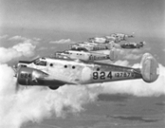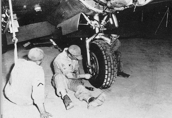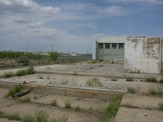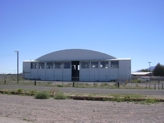
Deming
Army Air Field
The Bombardier School at the Deming Army Air Field was
established in 1942 and closed up in September, 1946.
The first class of bombardiers graduated on March 6,
1943. In the next three years an estimated 12,000 cadets
passed through the Deming school. With the end of World
War II, the bombardier training program at Deming wound down,
finally coming to an end in September, 1946. Deming Army
Air Field closed and the facility became the Deming Municipal
Airport. Currently (2005), some of the structures still
stand, including three hangars. The civilian operation
has mostly moved to the North side of the field, with the
South side becoming somewhat of a ghost town.
The units at DAAF appear to be in the following Structure, with the 321st Bombardier Training Group containing the flying units (equipped with AT-11s) and the 322nd BTG encompassing all of the ancillary units:
Army Air Forces Bombardier School
Deming Army Air Field
388th Base Headquarters and Air Base Squadron
321st Bombardier Training Group
Headquarters and Headquarters Squadron
971st Bombardier Training Squadron
972nd Bombardier Training Squadron
974th Bombardier Training Squadron
975th Bombardier Training Squadron
976th Bombardier Training Squadron
977th Bombardier Training Squadron
322nd Bombardier Training Group
Headquarters and Headquarters Squadron
Detachment 19 858th Signal Service Company (Aviation)
909th Guard Squadron
2053rd Ordnance Company
Medical Detachment
Veterinary Detachment
419th Army Air Forces Band
375th Aviation Squadron
1014th Quartermaster Platoon
Most of the following photos are taken from a yearbook
style book about the Deming Army Air Field published in 1943
by the Army And Navy Publishing Company of Baton Rouge,
Louisiana. This type of book was published for the
personnel stationed at various bases, but have become
increasingly difficult to find.
The
entire
purpose of the base,
The Bombardier.
 |
 |
 |
 |
 |
 |
 |
 |
 |
 |
 |
 |
For every
bombardier trainee there were a large number of support
personnel necessary to keep the training aircraft in the
air. Whether that be the mechanics, fuelers, or
ordinance groups. There are also the personnel
essential to every endeavor that seldom are recognized, like
cooks, bakers and even truck drivers. Two pages in the
1943 book are dedicated to Maintenance: "On these two pages maintenance
crews are seen at various repair jobs. This work is
the Air Forces biggest behind the scenes job. The
life of its pilots and efficiency of the planes depends on
the accuracy and skills of its maintenance crews."
Couldn't
put it better myself.
The above photos show mainly
engine maintenance, though the AT-11 in the hangar is most
likely going through a heavy check. The second and
third photos show the knuckle breaking, back aching work
done to keep the Pratt and Whitney R-975 engines in
shape. Piston engines are a favorite with enthusiasts,
but require a great many man hours to keep in prime
condition.
 |
 |
 |
 |
 |
 |
 |
 |
 |
 |
 |
 |
 |
 |
 |
 |
 |
 |
 |
 |
 |
Pleases send your comments and suggestions to:
My guest book is on the main page.
Page Created 07-14-05
Updated 05-10-20
Clifford Bossie